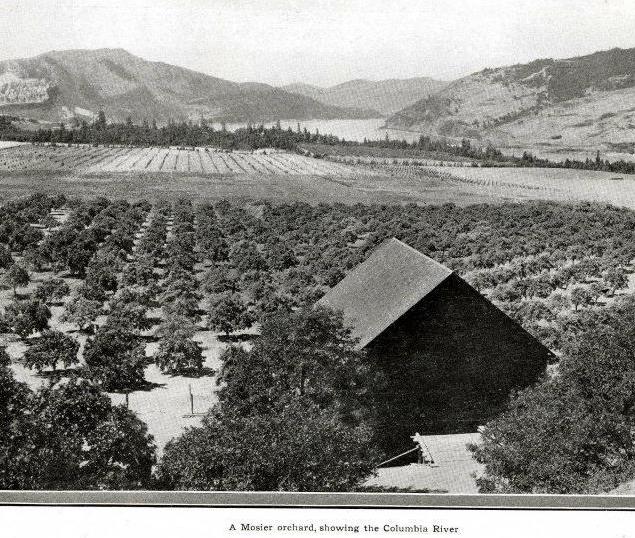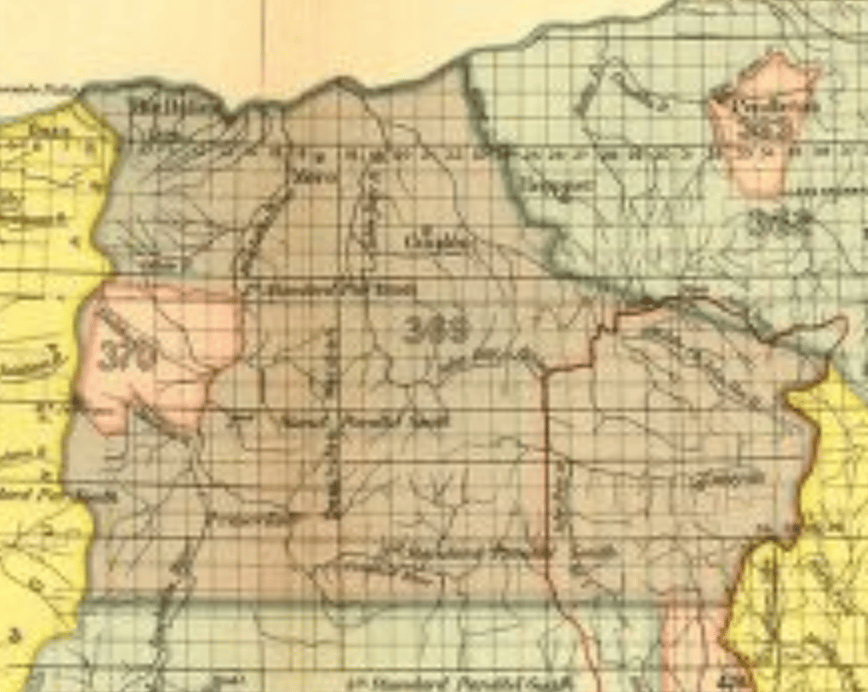Note: If any of the information on this page is inaccurate, misrepresentative, or incomplete, please let us know using the contact info on the right.
Indigenous People
The history of Mosier starts long before White settlers arrived in the 1800s. The Mosier Valley area falls within the traditional land inhabited by the Wasco tribe of native people, who lived on the south side of the Columbia River between what are now Hood River (where the Dog River band lived) and The Dalles (where the Ki-gal-twal-la band lived).[1] ‘Wasco’ is said to derive from the tribe’s word ‘wacq!ó’, meaning “cup” or “small bowl,” the name of a distinctive bowl-shaped rock near the tribe’s primary historic village[2] of Win-quatt (‘surrounded by rock cliffs’)[3], now The Dalles.
Together with the other tribes who lived along the Columbia River, the River People were the most powerful nation in the region due to their location along a major trading route, the Columbia River Gorge.[1] These were complex societies who lived in villages of multifamily plank houses.[4]

Their main trade item was salmon, which they caught and preserved in baskets that could hold up to a hundred pounds. Individually controlled fishing locations were allotted first to family members, then to neighboring villages, and lastly to any friendly visitors from farther away. Tribes traveled from hundreds away to trade for these salmon baskets.[2]
White Settlement
Then, of course, Lewis & Clark’s 1804-6 expedition mapped much of the interior of the Columbia River, but aside from trappers, fur traders, missionaries, and more explorers, few white settlers arrived until the western end of the Oregon Trail was developed. American emigration over the Oregon Trail began in earnest in the early 1840s.
The Oregon Territory was officially organized on August 13, 1848, and two years later, Congress passed the Donation Land Act, which gave settlers large tracts of land claimed by the federal government. By the time the law expired in 1855, more than 7,000 settlers had filed on more than 2.8 million acres in Oregon. This was before any treaties between Indian tribes and the United States government had been ratified.[4]
Mosier Founded
Jonah and Jane Mosier moved to The Dalles in the Oregon Territory in the fall of 1853 with their children. Mosier soon started working as a contractor, and constructed many of the wood commercial buildings in downtown The Dalles. After exhausting much of the local supply of wood, Jonah recognized another opportunity and settled on Donation Land Claim No. 37 near the confluence of the Columbia River and present-day Mosier Creek in 1854. He built a series of sawmills with partners near the Mosier Creek Falls to supply The Dalles with needed lumber. A boat landing was also established by Mosier to facilitate shipping to markets in The Dalles and other locations.[5]
As noted already, this settlement period had occurred without any negotiation with tribes, and not surprisingly, this lead to hostilities on both sides. The federal government’s solution was to pressure the tribes to move onto reservations. So in 1855, the Wasco, Warm Springs, and other tribes ceded approximately 10 million acres to the US government in exchange for 464,000 acres (about 1/20 of their original land base), and for the rights to self-govern, fish, and, and gather foods in the ceded lands.
The Wasco bands in the areas of Hood River and The Dalles signed the treaty, and moved to the new Warm Springs Reservation.[1]
Meanwhile, after losing his third and last sawmill to flooding, Jonah pursued the cattle business. He was a good businessperson and active in civic affairs. He served in the 1878 state legislature, and was a successful farmer and stock raiser.[5] In 1878, Amos Root established the Rosedale Fruit Farm, the first commercial orchard in the area.[6]

The transcontinental railroad through the Columbia Gorge reached Mosier in 1882, opening up the community to more settlement and trade, and the real history of the town of Mosier probably began then. By 1891, the population was about 100 residents.[5]
Mosier Gets Real
Their son Jefferson N. Mosier eventually acquired all the land Jonah and Jane had acquired – more than 1000 acres – as well as the land Jonah and his second wife, Martha Howard Lewis, accumulated. Although plans for a town site were started earlier, an official plat was not filed until after Martha’s death in 1903.

Jefferson promoted the productive fruit growing area, sold new lots in the town, started the water works, published the first town newspaper, the Mosier Bulletin, and organized and was first president of the Mosier Valley Bank; his biography was included in the 1922 and 1926 issues of “Who’s Who in Finance and Banking.” He was also active in the civic, fraternal and social organizations, and built one of the most prominent Victorian homes in Mosier above the State Road (the Mosier House, currently listed in the National Register of Historic Places).

Mosier became best known as an apple, cherry and prunes producing area.
By 1914, when the town was incorporated, the population was 500 and benefited from two churches, an Oddfellows hall, a new public school, the Mosier Fruit Growers’ Association, a Commercial Club building, a cider factory, a fire department, and a bank (established by Jefferson).

The town continued to prosper until 1919 when a fire destroyed half of the downtown. The business of the town never fully recovered.[5] The Columbia River Highway was completed through the Twin Tunnels in 1921, which increased tourism and travel through the area.
Recent Resurgence
By 1921, the population had dwindled to 250 despite the productive farmlands surrounding the small community.[5] People came and went over ensuing decades, and the population in 1990 was still only 244. But the next decade brought a 68% increase, and after the opening of the Historic Columbia River Highway State Trail in 2000, cyclist and tourist traffic surged. Almost 500 people called Mosier home in 2020, and it experiences substantial visitor traffic drawn by the various outdoor activities nearby.
Famous Oil Fire
On June 3, 2016, on a hot, still day, a near-disaster occurred which garnered Mosier national attention: a Union Pacific train carrying crude oil derailed, spilling 42,000 US gallons of volatile oil, and several cars caught fire. The fire began to spread southward through trees and underbrush toward Mosier Community School and the Mosier Manor part of town before it was contained. Several hundred residents were evacuated for two days. As of late 2022, the City government is still working with UPP to fully restore the site of the spill and fire.
Sources
[1] Warm Springs Community Action Team
[2] GorgeConnection
[4] NW Power and Conservation Council
[5] Mosier Pioneer Cemetery website
[7] Wikipedia






